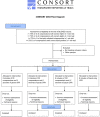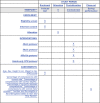Protocol of a Multicenter International Randomized Controlled Manikin Study on Different Protocols of Cardiopulmonary Resuscitation for laypeople (MANI-CPR)
- PMID: 29674365
- PMCID: PMC5914707
- DOI: 10.1136/bmjopen-2017-019723
Protocol of a Multicenter International Randomized Controlled Manikin Study on Different Protocols of Cardiopulmonary Resuscitation for laypeople (MANI-CPR)
Abstract
Introduction: Out-of-hospital cardiac arrest is one of the leading causes of death in industrialised countries. Survival depends on prompt identification of cardiac arrest and on the quality and timing of cardiopulmonary resuscitation (CPR) and defibrillation. For laypeople, there has been a growing interest on hands-only CPR, meaning continuous chest compression without interruption to perform ventilations. It has been demonstrated that intentional interruptions in hands-only CPR can increase its quality. The aim of this randomised trial is to compare three CPR protocols performed with different intentional interruptions with hands-only CPR.
Methods and analysis: This is a prospective randomised trial performed in eight training centres. Laypeople who passed a basic life support course will be randomised to one of the four CPR protocols in an 8 min simulated cardiac arrest scenario on a manikin: (1) 30 compressions and 2 s pause; (2) 50 compressions and 5 s pause; (3) 100 compressions and 10 s pause; (4) hands-only. The calculated sample size is 552 people. The primary outcome is the percentage of chest compression performed with correct depth evaluated by a computerised feedback system (Laerdal QCPR). ETHICS AND DISSEMINATION: . Due to the nature of the study, we obtained a waiver from the Ethics Committee (IRCCS Policlinico San Matteo, Pavia, Italy). All participants will sign an informed consent form before randomisation. The results of this study will be published in peer-reviewed journal. The data collected will also be made available in a public data repository.
Trial registration number: NCT02632500.
Keywords: cardiopulmonary resuscitation; feedback devices; training.
© Article author(s) (or their employer(s) unless otherwise stated in the text of the article) 2018. All rights reserved. No commercial use is permitted unless otherwise expressly granted.
Conflict of interest statement
Competing interests: None declared.
Figures
References
-
- Kette F, Sbrojavacca R, Rellini G, et al. . Epidemiology and survival rate of out-of-hospital cardiac arrest in north-east Italy: The F.A.C.S. study. Friuli Venezia Giulia Cardiac Arrest Cooperative Study. Resuscitation 1998;36:153–9. - PubMed
-
- Cummins RO, Ornato JP, Thies WH, et al. . Improving survival from sudden cardiac arrest: the "chain of survival" concept. A statement for health professionals from the Advanced Cardiac Life Support Subcommittee and the Emergency Cardiac Care Committee, American Heart Association. Circulation 1991;83:1832–47. 10.1161/01.CIR.83.5.1832 - DOI - PubMed
Publication types
MeSH terms
Associated data
LinkOut - more resources
Full Text Sources
Medical


